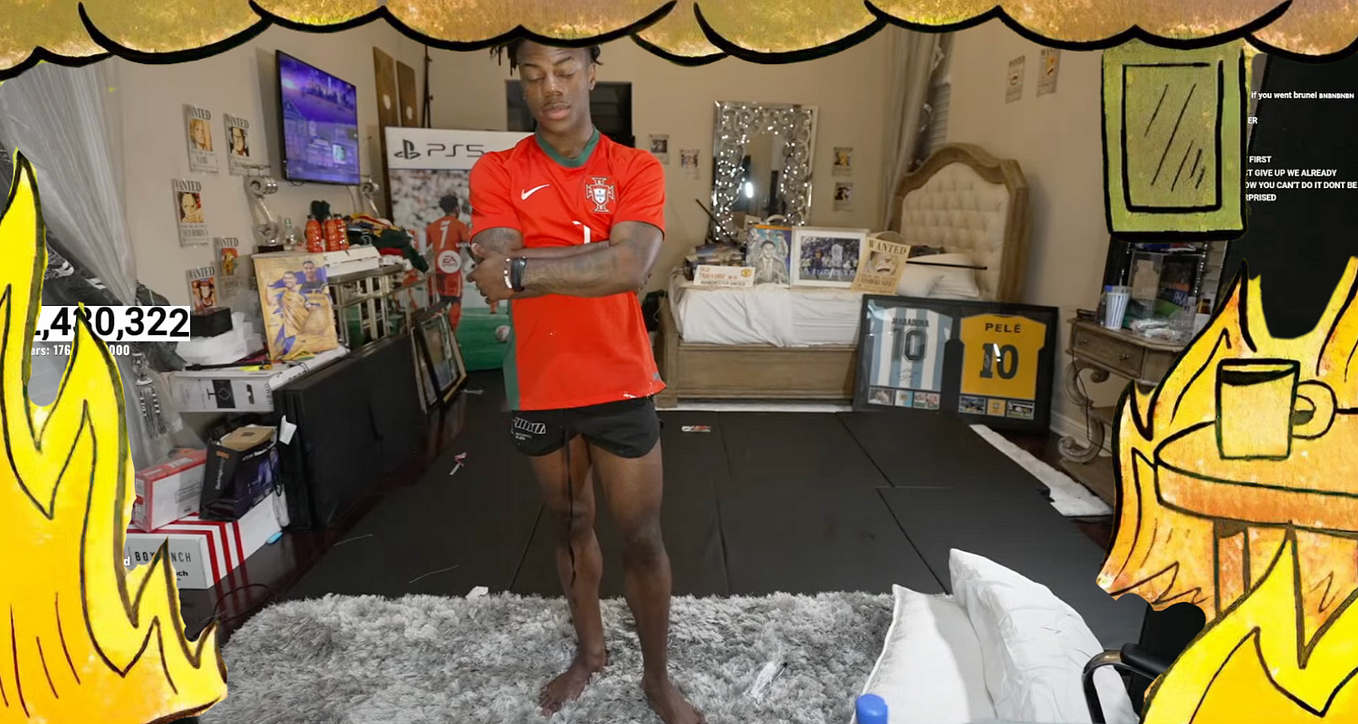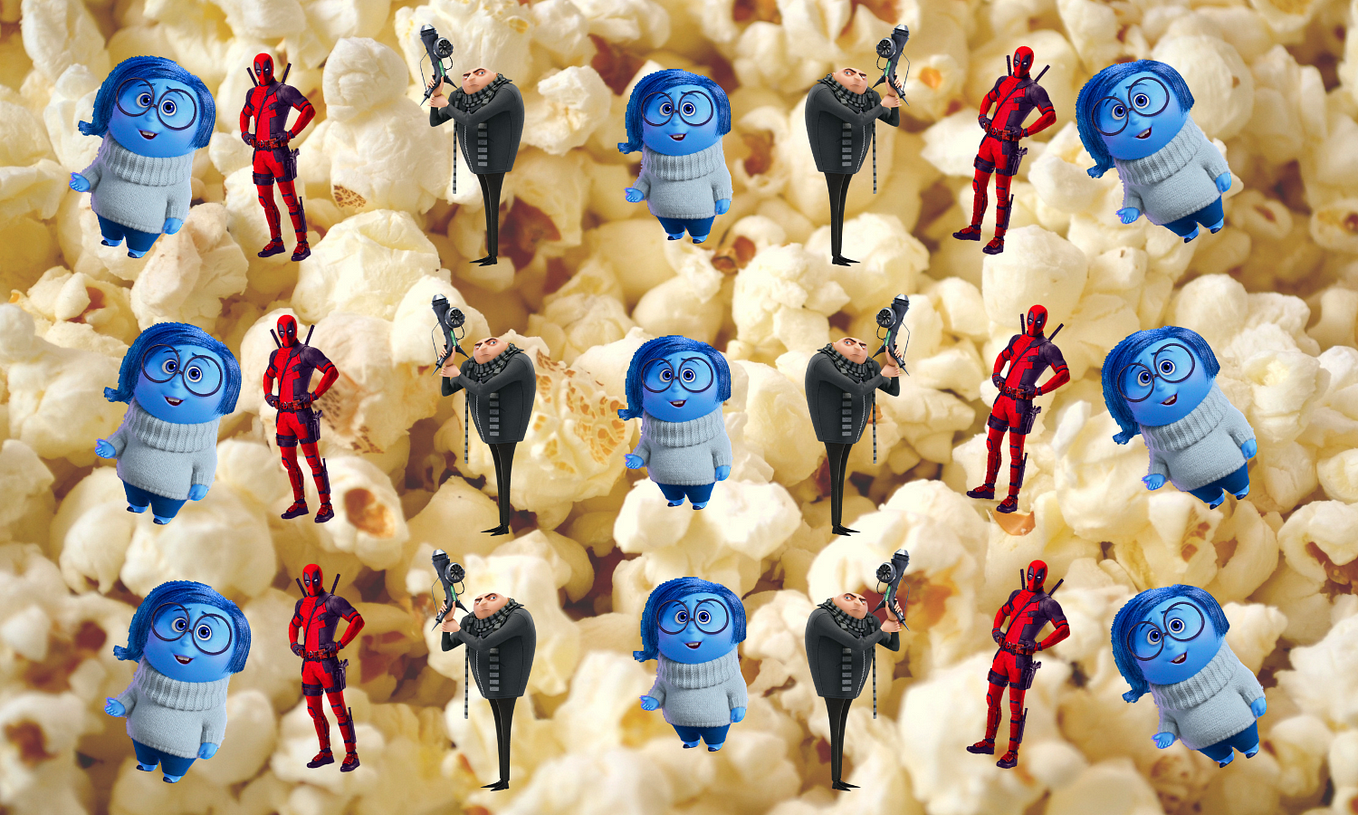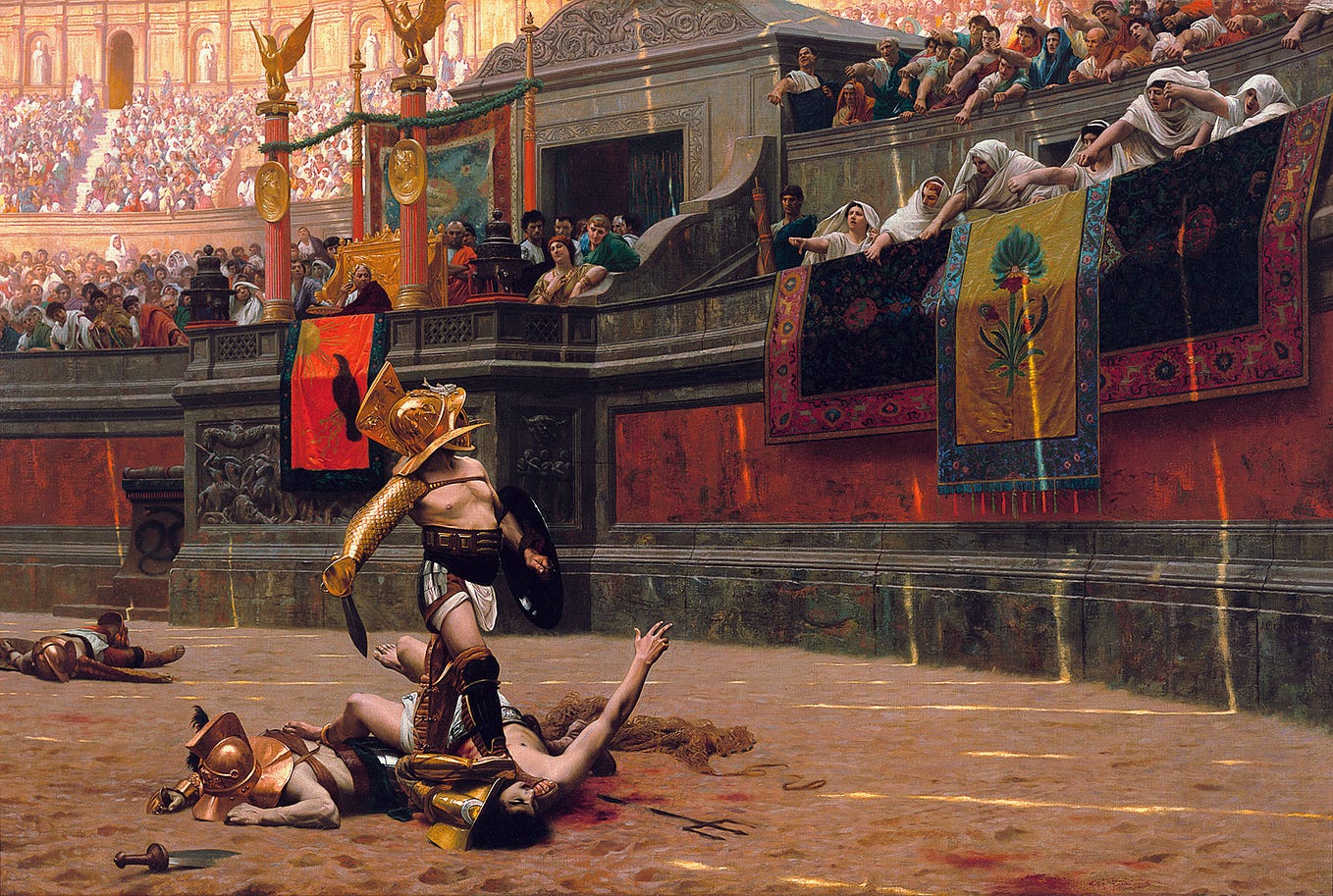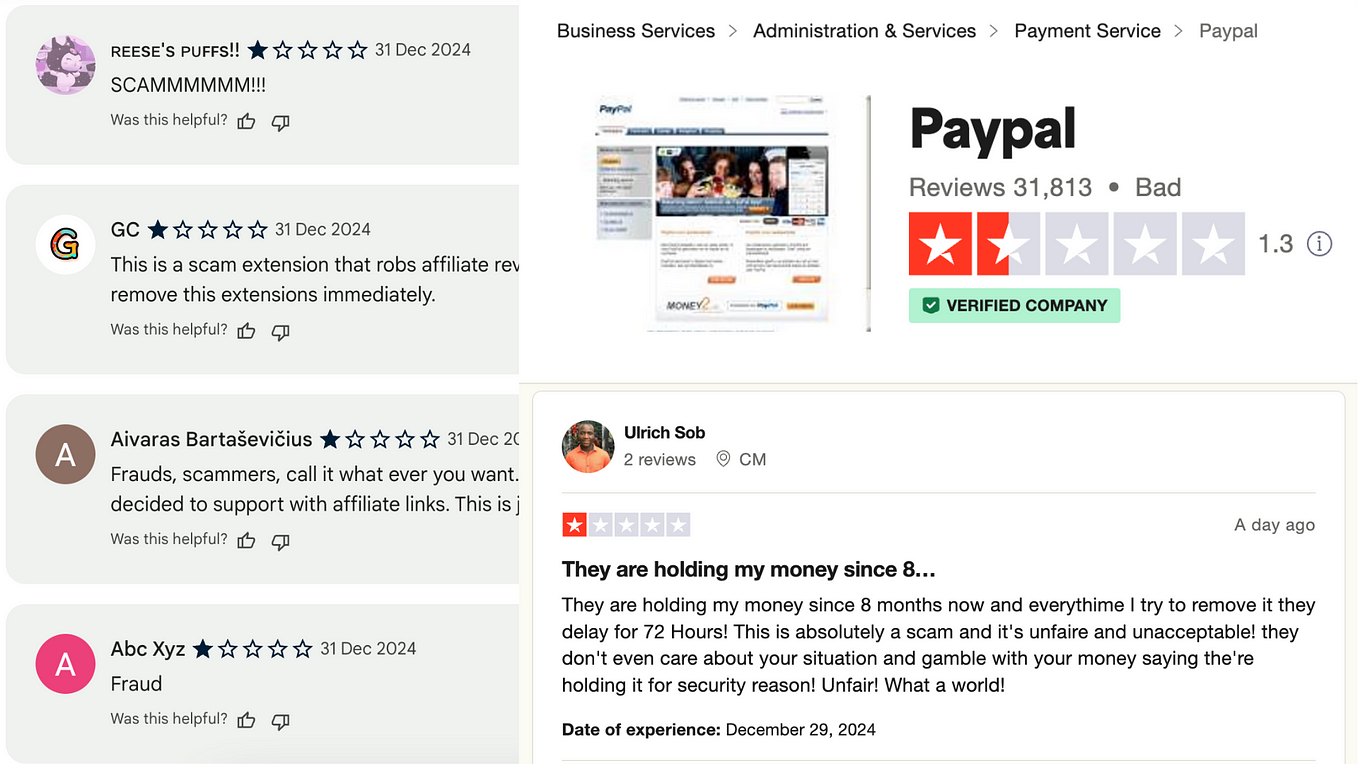It’s Time to End our Subscription Addiction
是时候结束我们的订阅成瘾了
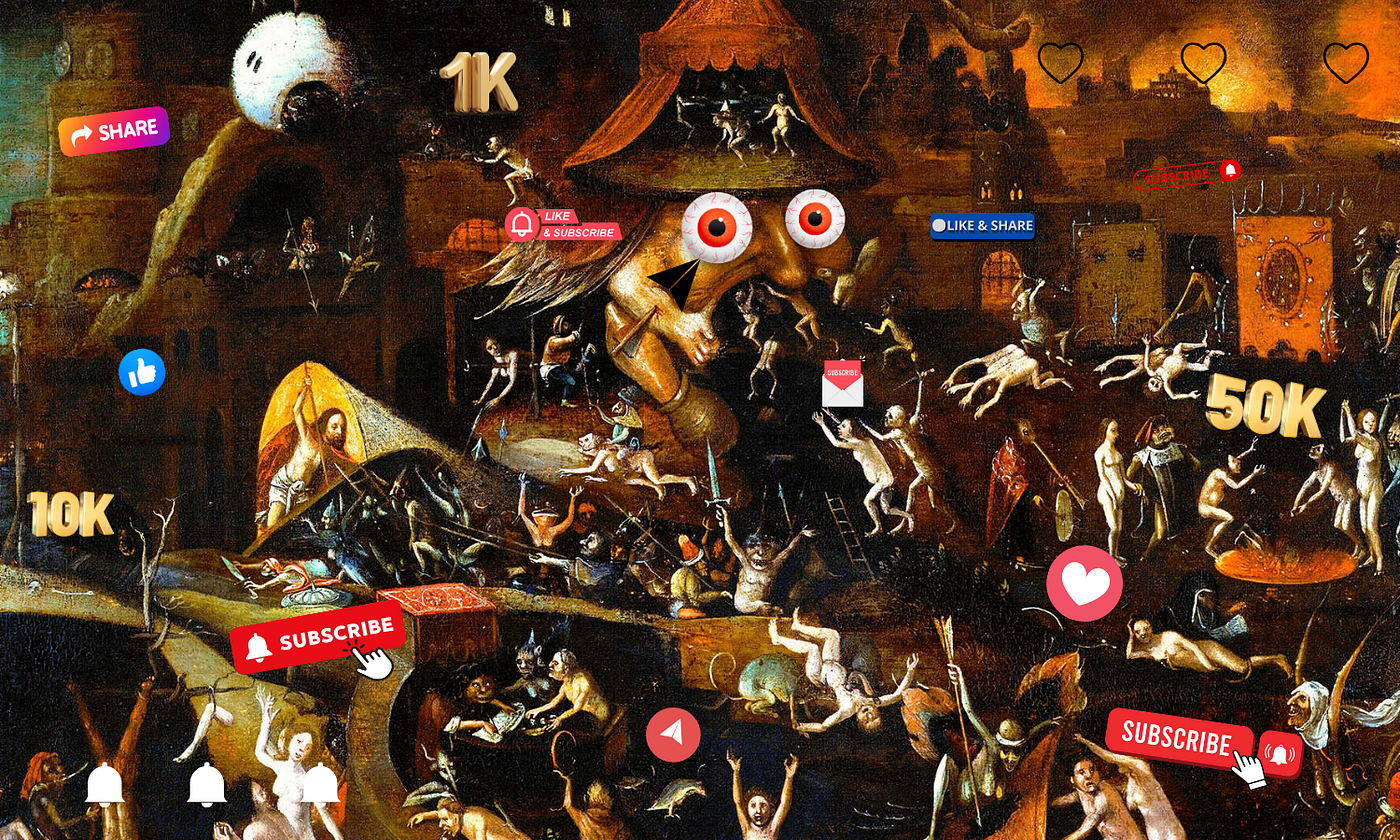
This post first appeared on my newsletter, Future Proof. It may seem lightly ironic, but I really value people subscribing to that and the small group of paid subscribers are vital to allowing me to write stuff like this, so do consider joining them.
这篇文章最初出现在我的通讯《未来保障》中。虽然这听起来有些讽刺,但我真的很重视人们订阅这个通讯,而那小部分付费订阅者对我能够写出这样的内容至关重要,所以请考虑加入他们。
There was a time, not that long ago, when the funniest writing in the world was happening on Twitter. And the undisputed philosopher-king among Twitter shit-posters was an account called dril. It is said, amongst my friends, that there’s a dril quote for everything, and I’d like to use one as an epigraph for this piece:
曾经不久之前,世界上最搞笑的文字创作发生在 Twitter 上。而在 Twitter 的恶搞发帖者中,毫无争议的哲学王是一个名为 dril 的账号。我的朋友们常说,dril 有句名言适用于一切,我想用其中一句作为这篇文章的引言:
“Food $200 Data $150 Rent $800 Candles $3,600 Utility $150 someone who is good at the economy please help me budget this. my family is dying”
“食品 $200 数据 $150 房租 $800 蜡烛 $3,600 公用事业 $150 有人擅长经济吗,请帮我制定预算。我的家人快撑不下去了。”
The joke is, obviously, that one shouldn’t spend $3,600 on candles. Those candles are too expensive — or you’re buying too many of them. But really, from an “economy” perspective, the issue is not the outgoing on candles but the relative cost compared to, say, rent. Spending almost 5 times as much on candles as rent seems a sufficiently absurd idea that we recognise it, immediately, as a joke. If someone was renting a $40,000 pcm apartment overlooking Hyde Park, would I be so shocked that they’re also spending $4k on candles? Not at all. The joke there would be quite different — the joke would be on us.
这个笑话显然是说,花 3600 美元买蜡烛是不应该的。这些蜡烛太贵了——或者你买得太多了。但实际上,从“经济”角度来看,问题不在于蜡烛的支出,而在于与租金相比的相对成本。花费几乎是租金五倍的钱在蜡烛上,似乎是一个足够荒谬的想法,以至于我们立刻就能识别出这是个笑话。如果有人租了一个每月 40000 美元的公寓,俯瞰海德公园,我会对他们花 4000 美元在蜡烛上感到震惊吗?一点也不会。那里的笑话会完全不同——笑话会在我们身上。
But how much should we spend on candles?
但是我们应该在蜡烛上花多少钱呢?
This is, I think, the most important question facing the entertainment industry, and broader media landscape, right now. The candles are — if it’s not apparent already — a metaphor. They represent life’s luxuries, big and small. Food, rent, utilities: these are unavoidable expenditures. Streaming platforms, video games, restaurants, football season tickets, craft beer, porn, Ubers home at 3am, artisan sourdough deliveries, the latest iPhone, a gold ornamental dolphin, new clothes in the sales, new clothes not in the sales (but really great value, I promise!), and, yes, a patchouli and sandalwood scented candle: these are life’s avoidable, but delicious, expenditures.
我认为,这是当前娱乐行业和更广泛媒体环境面临的最重要问题。蜡烛——如果还不明显的话——是一种隐喻。它们代表了生活中的奢侈品,无论大小。食物、房租、水电费:这些是不可避免的支出。流媒体平台、视频游戏、餐厅、足球季票、手工啤酒、凌晨 3 点的 Uber、手工酸面包配送、最新款 iPhone、一只金色装饰海豚、打折的新衣服、非打折的新衣服(但真的很划算,我保证!),还有,是的,一支香根草和檀香味的蜡烛:这些是生活中可以避免但又令人愉悦的支出。
There has been much talk, throughout 2024, about the cost of living. Rising inflation has been a staggeringly effective force for change throughout the world: no major election in 2024 was won by the incumbent. Here in the UK, the Tories were swept aside by the cost of salad; in the US, it’s clear that inflation at the gas pump Trumped the, very real, economic progress of the Biden administration. But what I want to discuss today (so settle down children, get yourself a snack and a fizzy water) is less the rising cost of everything, but the rising everyness of cost. (That is a very fun but confusing way of expressing: things that used to be free now cost money. Things that used to be bundled into a single fee are now spread into several. Candles, candles, candles.) There’s probably a term in real economics for this (it’s not dissimilar to shrinkflation), but, on the off chance there isn’t, I’ll take a stab at a coinage: spreadflation.
在 2024 年,关于生活成本的讨论非常频繁。不断上升的通货膨胀在全球范围内成为了一个惊人的变革力量:2024 年没有任何一场主要选举是由现任者赢得的。在英国,保守党被沙拉的成本所击败;在美国,显然,加油站的通货膨胀压倒了拜登政府非常真实的经济进展。但我今天想讨论的(所以孩子们,安静下来,给自己准备点零食和气泡水)不是一切成本的上升,而是成本的普遍上升。(这是一种非常有趣但令人困惑的表达方式:曾经免费的东西现在需要花钱。曾经捆绑在一个费用中的东西现在分散成几个。蜡烛,蜡烛,蜡烛。)在真实经济学中可能有一个术语来描述这个现象(这与收缩性通货膨胀并不相似),但如果恰好没有,我就试着创造一个词:扩散性通货膨胀。
In the summer of 2023, I wrote a piece called ‘The End of the Subscription Era is Coming’. The central thesis of this was that the rise of separate subscriptions for things like entertainment and journalism was unsustainable. The overall costs of these things were rising too steeply, even if atomised subscriptions seemed to reduce waste. That piece has been read hundreds of thousands of times and has clearly resonated with people. Most of all, I suspect, it’s resonated with solo publishers who have felt themselves to be the casualties of this trend.
在 2023 年夏天,我写了一篇名为《订阅时代的终结即将来临》的文章。文章的中心论点是,娱乐和新闻等领域的独立订阅的兴起是不可持续的。这些内容的整体成本上升得太快,即使分散的订阅似乎减少了浪费。这篇文章已经被阅读了数十万次,显然引起了人们的共鸣。最重要的是,我怀疑它引起了那些感到自己是这一趋势受害者的独立出版者的共鸣。
Put very simply: Jeremy Normalbloke is the writer of The Normalbloke Manifesto, a newsletter that’s been running for several years. In the early days of Substack, he moved over to the platform because it was easy to use and growing fast. Within a year on Substack The Normalbloke Manifesto had 10,000 subscribers, of whom 320 paid £10 a month for premium access, giving Jeremy a pre-tax revenue stream of £38,400 a year. Jeremy was delighted: he could finally earn a living writing, without being answerable to anyone. His newsletter had a solid base and, presumably, he would continue to add subscribers at a faster rate than he’d lose them.
简单来说:Jeremy Normalbloke 是《The Normalbloke Manifesto》的作者,这是一份已经运行了几年的通讯。在 Substack 的早期,他转到这个平台,因为它易于使用且发展迅速。在 Substack 的一年内,《The Normalbloke Manifesto》拥有了 10,000 名订阅者,其中 320 人每月支付 10 英镑以获得高级访问权限,这使 Jeremy 每年的税前收入达到了 38,400 英镑。Jeremy 非常高兴:他终于可以靠写作谋生,而不必向任何人负责。他的通讯有了坚实的基础,推测他将继续以比失去订阅者更快的速度增加订阅者。
But two things happened in the past couple of years to disrupt Jeremy’s cashflow. The first is that more publications and journalists introduced hard paywalls for their content. This meant that Jeremy’s readers were now having to make an active choice about what they subscribe to. Could they afford to spend £10 on The Normalbloke Manifesto, a bi-weekly email, when they also had to spend $25 a month for the New York Times? Plus, when Jeremy launched TNM, his subscribers, on average, signed-up to 2.5 Substacks. Now, that average has risen to 10. It is not just the accumulating costs that are bothering Jeremy, but the engagement. Open rates are falling, even as total subscriber figure edge up, as are shares. If people don’t read his work, are they really going to migrate to the premium version? And so, as 2025 looms, Jeremy is worried that making an income solely from The Normalbloke Manifesto is no longer sustainable. He know that 35% of his 320 paid subscribers joined with a special New Year offer he runs, and so he’s aware that, by the end of January, that figure could be significantly reduced. Will they renew their subscriptions? Or will they spend their money, and attention, elsewhere?
但在过去的几年里,有两件事打乱了杰里米的现金流。首先,越来越多的出版物和记者为他们的内容引入了严格的付费墙。这意味着杰里米的读者现在必须主动选择他们订阅的内容。当他们还需要每月花费 25 美元订阅《纽约时报》时,他们能否负担得起每两周 10 英镑的《普通人宣言》?此外,当杰里米推出 TNM 时,他的订阅者平均订阅了 2.5 个 Substack。现在,这一平均数已上升到 10。困扰杰里米的不仅是不断增加的成本,还有参与度。尽管总订阅人数在上升,但打开率和分享率却在下降。如果人们不阅读他的作品,他们真的会转向付费版本吗?因此,随着 2025 年的临近,杰里米担心仅靠《普通人宣言》获得收入已不再可持续。他知道,320 名付费订阅者中有 35%是通过他推出的新年特惠加入的,因此他意识到,到一月底,这一数字可能会大幅减少。他们会续订吗? 他们会把钱和注意力花在其他地方吗?
This is a fictional example. Jeremy is actually in rude financial health, as it is very cheap to be imaginary right now. But I suspect it will resonate with a lot of people, not just on Substack but across the media. Podcasters, YouTubers, social creators, freelance journalists, OnlyFans models, indie musicians, video game streamers, whoever.
这是一个虚构的例子。杰里米实际上财务状况良好,因为现在想象中的成本非常低。但我怀疑这会引起很多人的共鸣,不仅是在 Substack 上,而是在整个媒体行业。播客主持人、YouTuber、社交创作者、自由记者、OnlyFans 模特、独立音乐人、视频游戏主播,等等。
18 months ago, I said that the subscription era was bound to face its limitations sooner or later. “The inflection point is coming,” I wrote, “When creators realise the dream of financial success and celebrity is sputtering, so too will the impression that this is a radical new future for content creation fade.” And yet, since then, the subscription era has not ended. Has not even, really, been challenged. In point of fact, a number of things have happened to consolidate the hegemony of the subscription model, and make more acute its issues for independent creators.
18 个月前,我说过订阅时代迟早会面临局限。“拐点即将到来,”我写道,“当创作者意识到财务成功和名声的梦想正在熄灭时,这种内容创作的激进新未来的印象也将消退。”然而,自那时以来,订阅时代并没有结束。实际上,甚至没有真正受到挑战。事实上,发生了一些事情,巩固了订阅模式的霸权,并使其对独立创作者的问题更加尖锐。
One of the biggest of these has been Elon Musk’s desecration of the website formerly known as Twitter. You may think whatever you like of Elon Musk as a businessman and technological innovator — and the continued success of SpaceX and Tesla is commendation enough — but he has run Twitter/X into the ground. This has had many corollary results, one of which is the creation of a digital refugee class amongst online liberals. Much ink has been spilled on the success of Bluesky (I remain to be convinced that it is much more than a talking shop for journos and academics), but the biggest beneficiary, probably, is Substack. The migration from X to Substack has been quick and vast. Writers who had been exhibiting their work on Twitter for a decade have started a Substack account and — hey, why not? — launched a little publication and — yeah, I guess there’s no reason not to — introduced a small subscription tier. It has fundamentally changed what Substack is, from a publisher focused platform to a mixed creator-audience one.
这些变化中最大的一项是埃隆·马斯克对曾被称为 Twitter 的网站的亵渎。你可以对埃隆·马斯克作为商人和技术创新者有任何看法——而 SpaceX 和特斯拉的持续成功足以证明他的能力——但他确实把 Twitter/X 搞得一团糟。这带来了许多附带的结果,其中之一是在在线自由派中形成了一种数字难民阶层。关于 Bluesky 的成功已经有很多讨论(我仍然不相信它比记者和学者的讨论平台更有价值),但最大的受益者可能是 Substack。从 X 到 Substack 的迁移迅速而广泛。那些在 Twitter 上展示自己作品已有十年的作家们开始注册 Substack 账户——嘿,为什么不呢?——推出了一本小出版物——是的,我想没有理由不这样做——并引入了一个小的订阅层级。这从根本上改变了 Substack 的性质,从一个以出版为中心的平台转变为一个混合创作者与受众的平台。
Musk’s Twitter also exposes another online trend that is entrenching the subscription era: platform stickability. If there is one thing that seems to obsess the bods at X — and, to be fair, Meta, Google etc — it’s the idea of getting people to stay on-platform for longer. This is a subject that I want to write properly on, but let’s focus, for now, on its impacts. Twitter (as was) is now prioritising longer form content: longer written posts and, particularly, longer videos. TikTok has, in the past year or so, increased the maximum upload time to 60 minutes (or 10 minutes when recorded in-app). Micro-blogging has become blogging; short-form video has become video.
马斯克的推特还揭示了另一个正在巩固订阅时代的在线趋势:平台粘性。如果说有一件事让 X 的团队(公平地说,Meta、谷歌等)感到痴迷,那就是让人们在平台上停留更长时间的想法。这是我想认真写的一个主题,但现在让我们先关注它的影响。推特(当时的样子)现在优先考虑长形式内容:更长的书面帖子,特别是更长的视频。过去一年左右,TikTok 将最大上传时间增加到 60 分钟(或在应用内录制时为 10 分钟)。微博客已变成博客;短视频已变成视频。
But how does this impact our subscription addiction? Put simply, it’s a drag on the ability of media organisations to do journalism. Almost every publication and writer has, for some years, been using social media. Over the past couple of years they’ve noticed a de-prioritisation of links. In essence, the ‘algorithm’ (by which I mean, the executive level decision makers) are privileging content where people remain in-app over content that takes them elsewhere. This has had a huge, ginormous, massively under-reported impact on the great metric of digital success: traffic.
但这对我们的订阅依赖有什么影响呢?简单来说,这对媒体组织进行新闻报道的能力造成了拖累。几乎每个出版物和作者在过去几年中都在使用社交媒体。在过去的几年里,他们注意到链接的重要性被降低了。实质上,“算法”(我指的是高层决策者)更倾向于那些让人们留在应用内的内容,而不是将他们引导到其他地方的内容。这对数字成功的一个重要指标——流量,产生了巨大的、极其庞大的、被严重低估的影响。
Traffic has been the dominant way of assessing media success for some time, and its importance harks back to what is sometimes referred to as ‘the original sin of the internet era’. (Side note: I can never find a citation for this, but I’d like one as it’s a great point, and one I often publicly agree with*). The original sin of the internet era, it is said, was to make it free. That freeness allowed it to grow like topsy, to hook not just the youthful generations, but every living generation, on information and entertainment at our fingertips. The question of how the internet would become profitable was a question for sometime in the future. And then the future arrived and, with a careless shrug, a bunch of media moguls said “um, I dunno, maybe advertising?”
流量一直是评估媒体成功的主要方式,其重要性可以追溯到有时被称为“互联网时代的原罪”。(旁注:我从未找到过这个说法的引用,但我希望能找到一个,因为这是一个很好的观点,我常常公开表示赞同*)。人们说,互联网时代的原罪在于让它变得免费。这种免费的特性使其像野草一样生长,不仅吸引了年轻一代,还吸引了每一个生活中的世代,让人们随时随地获取信息和娱乐。互联网如何盈利的问题曾是未来的一个问题。然后未来到来了,一群媒体大亨漫不经心地耸耸肩说:“嗯,我不知道,也许是广告?”
Advertising is a staggeringly inefficient method of revenue generation. It essentially involves the careful crafting of a sellable product, and then not selling it but, instead, using it to push other (often less carefully crafted) sellable products. Stop and think, for a moment, about the idea of commissioning a journalist to write a long feature on, say, the fact that “tenderstem” broccoli is a licensed trademark owned by a Japanese seed company. That piece is then edited, sub-edited and factchecked, enhanced with illustrations by a printmaker famous for vegetable designs, and then published online. And, crudely embedded in the middle of the piece, is an advert for drop-shipped Stanley cups for teenage girls.
广告是一种极其低效的收入生成方式。它基本上涉及精心制作一个可销售的产品,然后不去销售它,而是用它来推动其他(通常是制作得不那么精细的)可销售产品。停下来想一想,委托一位记者撰写一篇关于“嫩茎”西兰花是由一家日本种子公司拥有的注册商标的长篇特写的想法。这篇文章随后经过编辑、次级编辑和事实核查,配以一位以蔬菜设计闻名的版画家的插图,然后在线发布。而在文章中间粗略嵌入的是一则针对青少年女孩的斯坦利杯的广告。
We didn’t make people pay for journalism when the internet was in its infancy, and now, as it enters maturity, nobody knows the value of anything. We are trying to retrofit direct sales into the industry — that’s what the subscription era is all about — and it’s confusing as hell. We got hooked on an unlimited stream of free media — an all you can eat buffet of stir-fried Tenderstem® broccoli — and now we’re paying the price. And so, in the absence of direct exchange of money for goods, digital advertising was asked to carry the weight of funding our media addiction, which meant that ‘traffic’ became King of the Metrics. And in the court of King Traffic I, social media was Richard Neville, 16th Earl of Warwick: kingmaker.
当互联网处于初期阶段时,我们并没有让人们为新闻付费,而现在,随着它进入成熟期,没人知道任何事物的价值。我们正在努力将直接销售引入这个行业——这就是订阅时代的全部内容——而这让人感到非常困惑。我们沉迷于无限量的免费媒体——一场可以随意享用的炒嫩茎西兰花自助餐——而现在我们正在为此付出代价。因此,在缺乏直接用金钱交换商品的情况下,数字广告被要求承担资助我们媒体成瘾的重任,这意味着“流量”成为了指标之王。在流量之王的法庭上,社交媒体则是理查德·内维尔,沃里克的第 16 代伯爵:造王者。
Social media could make or break a publication and an author. People were routinely commissioned on the strength of their Twitter following. That sacred number came up in job interviews, in negotiations for book deals. It became a psychological sickness at the heart of journalism — an addict’s craving for affirmative dopamine rushes that was also, perversely, really professionally important. That hasn’t unravelled fully: whether it’s Twitter or Bluesky or TikTok or Substack, there’s still a number and that number is still valuable. But most of these platforms are now in competition with the publishers they were previously co-existing with. Symbiosis has given way to amensalism.
社交媒体可能会成就或毁掉一个出版物和一个作者。人们常常根据他们的 Twitter 粉丝数量被委托。这一神圣的数字在求职面试和书籍交易的谈判中频繁出现。它成为了新闻业中心的心理病态——一种对肯定的多巴胺冲动的上瘾,这在某种程度上又是职业上非常重要的。这种情况并没有完全解开:无论是 Twitter、Bluesky、TikTok 还是 Substack,仍然有一个数字,而这个数字依然有价值。但这些平台现在大多与它们曾经共存的出版商竞争。共生关系让位于寄生关系。
The doom of traffic has meant that almost the entire media industry has had to move away from digital advertising and towards a hard-paywall. I meet few people, who don’t work in digital advertising, who have anything positive to say about the future of digital advertising. More hard-paywalls mean more subscriptions. More subscriptions means a higher expenditure on media consumption. And that all builds towards this sense of spreadflation.
交通的困境意味着几乎整个媒体行业不得不放弃数字广告,转向严格的付费墙。我遇到的几乎所有不从事数字广告的人,对数字广告的未来都没有什么积极的看法。更多的付费墙意味着更多的订阅。更多的订阅意味着在媒体消费上的支出增加。这一切都加剧了这种扩散通胀的感觉。
What is a normal media diet? Jeremy Normalbloke, when he’s not publishing his newsletter, is, helpfully, a completely average guy. He has pretty standard interests (he likes films, TV, fly fishing), political views (he’s a moderate, whatever that means) and has the high-end of average education and income. He is, basically, the man the whole of the media is targeting. He subscribes to Netflix and has done for years, but has also introduced Amazon Prime, because of the delivery extras, and Disney+, for the kids. He has a Spotify family plan and Audible for dog-walking self-improvement. He subscribes to the New York Times, for the puzzles, and the Financial Times, because his parents think it’s good for him. He subscribes to three Substacks: one about fly fishing, and two out of a sense of social obligation to friends. He has a subscription to PlayStation Plus, so he can game with overseas friends, and his son has forced him to take out a Fortnite Crew subscription. He also, though this is put through on his secret Monzo account, pays for two OnlyFans models, not because he finds them sexy but because they “seem like really nice girls and also really smart.”
什么是正常的媒体饮食?杰里米·诺曼布洛克在不发布他的新闻通讯时,实际上是一个完全普通的人。他的兴趣相当标准(他喜欢电影、电视、飞钓),政治观点(他是一个温和派,不管这意味着什么),并且拥有高于平均水平的教育和收入。基本上,他就是整个媒体所针对的人。他订阅了 Netflix,并且已经订阅多年,但也因为送货的额外服务而加入了 Amazon Prime,还为孩子们订阅了 Disney+。他有一个 Spotify 家庭计划和 Audible,用于遛狗时的自我提升。他订阅了《纽约时报》,因为喜欢解谜游戏,还订阅了《金融时报》,因为他的父母认为这对他有好处。他订阅了三个 Substack:一个关于飞钓,另外两个出于对朋友的社会责任感。他还订阅了 PlayStation Plus,以便与海外朋友一起游戏,他的儿子强迫他订阅了 Fortnite Crew。尽管这笔费用通过他的秘密 Monzo 账户支付,他还为两个 OnlyFans 模特付费,并不是因为他觉得她们性感,而是因为她们“看起来真的是很好的女孩,而且也很聪明。”
So what does this cost Jeremy? Mercifully, he lives in the UK, so I can find the details pretty quickly (I have used average monthly costs for both Substack and OnlyFans). The current exchange rate of GBP to USD is 1:1.25.
那么这对杰里米来说要花多少钱呢?幸运的是,他住在英国,所以我可以很快找到详细信息(我使用了 Substack 和 OnlyFans 的平均月费用)。当前英镑对美元的汇率是 1:1.25。
Monthly costs: Netflix (£17.99), Amazon Prime (£8.99), Disney+ (£12.99), Spotify (£11.99), Audible (£7.99), New York Times online (£8), Financial Times (£39), Substacks (3 x £5), Playstation Plus Premium (£13.49), Fortnite Crew (£9.99), OnlyFans (2 x £7). Total spend: £159.43. (please help me budget this. my family is dying).
每月费用:Netflix(£17.99),Amazon Prime(£8.99),Disney+(£12.99),Spotify(£11.99),Audible(£7.99),纽约时报在线(£8),金融时报(£39),Substacks(3 x £5),Playstation Plus Premium(£13.49),Fortnite Crew(£9.99),OnlyFans(2 x £7)。总支出:£159.43。(请帮我制定预算。我家快撑不下去了)。
Essentially, Jeremy is spending £2,000 a year on subscription media. That’s without things like cinema or concert tickets, books or magazines or newspapers, PPVs from these “really smart girls who are saving up for night school”. It’s a subscription basis that requires him to spend £70 on the latest video game, so that he can use his network capabilities, or £200 on Bang & Olufsen headphones so that he can really immerse himself in high-fidelity streaming of the new Billie Eilish album. And Jeremy is just a normal consumer: some people are trying to maintain 30 Substack subscriptions. Some people feel like they need NowTV and AppleTV+ and Paramount Plus and HBO Max and DAZN and Hayu and Hulu and Rakuten as well as Netflix, Amazon and Disney+. And Jeremy is, most importantly, not interested in football, otherwise he’d need the Sky (£35) and TNT (£30) sports packages.
本质上,杰里米每年在订阅媒体上花费 2000 英镑。这还不包括电影或音乐会门票、书籍、杂志或报纸,以及这些“真的很聪明的女孩们为夜校存钱”的 PPV。他的订阅模式要求他花 70 英镑购买最新的视频游戏,以便利用他的网络功能,或者花 200 英镑购买 Bang & Olufsen 耳机,以便真正沉浸在比莉·艾利什新专辑的高保真流媒体中。而杰里米只是一个普通消费者:有些人试图维持 30 个 Substack 订阅。有些人觉得自己需要 NowTV、AppleTV+、Paramount Plus、HBO Max、DAZN、Hayu、Hulu,以及 Netflix、Amazon 和 Disney+。而最重要的是,杰里米对足球并不感兴趣,否则他还需要 Sky(35 英镑)和 TNT(30 英镑)的体育套餐。
No, it’s quite clear that consumers are being screwed. The subscription era has peddled, in unholy tandem, along with the licensing era, which is even more pernicious. Back in the good old days, I could buy a copy of Microsoft Word and that would be mine, forever. Now I buy a “license” to run Microsoft Word on my MacBook (AppleCare: £34.99 per year) and Microsoft charges me £5.99 a month for that privilege. The same is true, essentially, of all the software I might reasonably use: Adobe, Logic Pro, Canva, Hindenberg, whatever. I don’t really own anything, anymore, I just rent the right to use it for a while.
不,消费者显然被剥削了。订阅时代与许可时代不幸地勾结在一起,后者甚至更加恶劣。在美好的旧时光里,我可以购买一份 Microsoft Word 的副本,那将永远属于我。现在,我购买的是在我的 MacBook 上运行 Microsoft Word 的“许可”(AppleCare:每年 34.99 英镑),而微软每月向我收取 5.99 英镑的费用。基本上,我可能合理使用的所有软件都是如此:Adobe、Logic Pro、Canva、Hindenberg,等等。我现在真的不再拥有任何东西,我只是租用使用它的权利。
Downstream of consumers being screwed (after all, consumers have to be at least partially screwed in order for the great engine of capitalism to keep running) are the content creators, also being screwed.
消费者被剥削的下游(毕竟,消费者至少要在一定程度上被剥削,以便资本主义的伟大引擎能够继续运转)是内容创作者,他们也在被剥削。
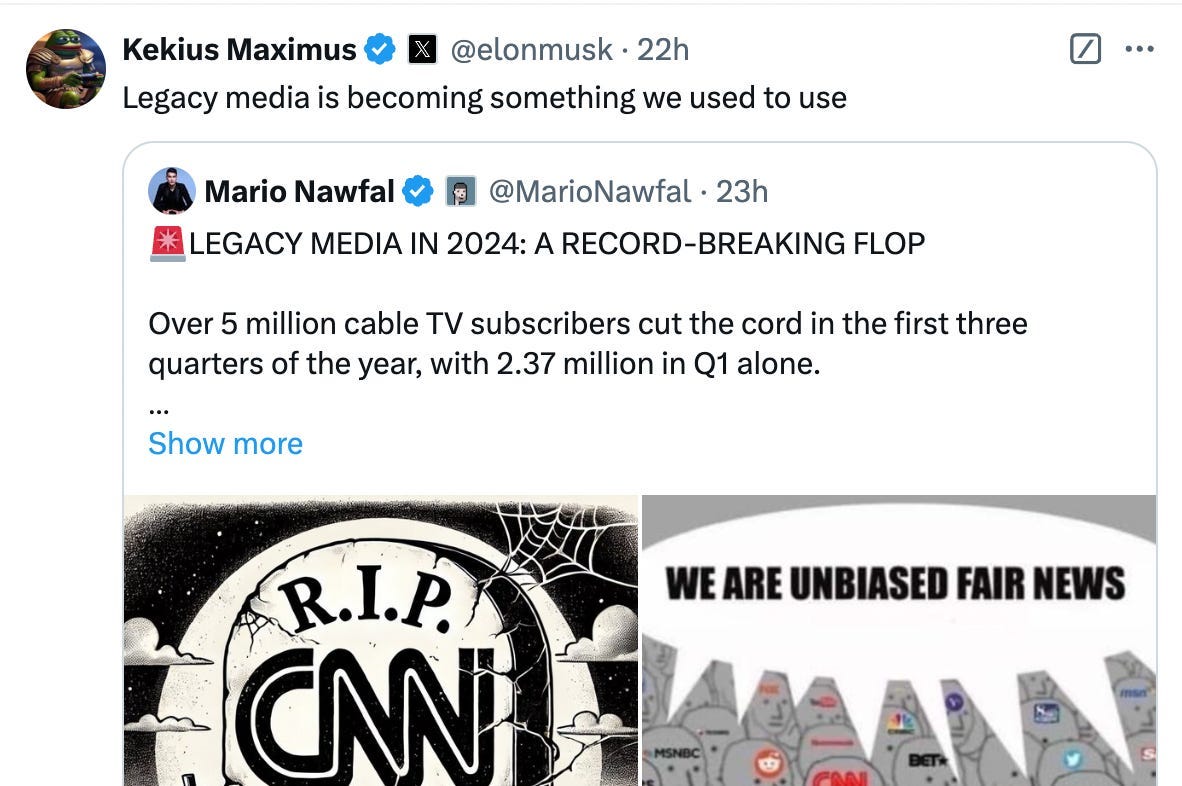
There is a temptation, always, to bear witness to a gold rush. Elon Musk has repeatedly told his followers on X that they are the media now, and much has been made of the munificence of his new partner programme (though I have yet to see any clear, broken-down reports on earnings). All the same, just look at the publications he actually interacts with. Take, for example, The Babylon Bee, a conservative satire site that Musk restored to Twitter following their 2022 ban. Musk regularly interacts with them, retweets their content and has been interviewed on the site. Yet, when I go on their website I am immediately greeted with a pop-up that yells: “Get a Babylon Bee subscription today to watch our new movie!”. When I dismiss the pop-up I can see that it was hiding a button saying ‘join’. It costs $6–12 a month to ‘join’ the Babylon Bee. And then there’s also a ‘shop’ where I can buy a ‘FAKE NEWS’ hoodie for just £40. I log-off, instead.
总是有一种诱惑,让人见证一场淘金热。埃隆·马斯克在 X 上反复告诉他的追随者,他们现在就是媒体,而他的新合作伙伴计划的慷慨也引起了很多关注(尽管我还没有看到任何清晰的、详细的收益报告)。尽管如此,看看他实际上与哪些出版物互动就知道了。例如,保守派讽刺网站《巴比伦蜜蜂》,马斯克在 2022 年解除他们的 Twitter 禁令后恢复了该网站。马斯克定期与他们互动,转发他们的内容,并在该网站上接受采访。然而,当我访问他们的网站时,立刻就会弹出一个窗口,喊着:“今天就订阅《巴比伦蜜蜂》,观看我们的新电影!”当我关闭弹窗时,我发现它隐藏了一个写着“加入”的按钮。加入《巴比伦蜜蜂》每月需要 6 到 12 美元。还有一个“商店”,我可以花 40 英镑买一件“假新闻”连帽衫。我选择注销。
Even though I personally don’t care about the fundraising travails of The Babylon Bee, it is typical of a simple fact: it doesn’t matter how much you lick the boots of the Big Tech establishment, there is no getting away from the brutal realities of the subscription era. Revenue sources are not simple. Just look at X itself, which has just sent me a push notification begging me to take out a premium subscription. (They are, themselves, a fascinating example of a correct thesis — digital advertising is doomed — coupled with a horrific solution — alienate all digital advertisers and then push subscription access to the remaining hellscape). This subscription obsession positions access over ownership, and if consumers never have something tangible to hold onto, then the ability is always there to spread and spread and spread. Before, if you wanted to own three films — Monster, Monster’s Ball, and Monsters, Inc, say — you would buy three DVDs and you’d have them forever. Now you’ll need a bunch of different streaming services to pin down rotating libraries and complex IP deals. You can never truly own Monster, Monster’s Ball and Monsters, Inc anymore (unless you already have them on DVD, in which case, you’re sorted).
尽管我个人并不关心《巴比伦蜜蜂》的筹款困境,但这反映了一个简单的事实:无论你多么迎合大科技公司的利益,订阅时代的残酷现实是无法逃避的。收入来源并不简单。看看 X 本身,它刚刚给我发了一条推送通知,恳求我订阅高级服务。(它们本身就是一个正确论点的迷人例子——数字广告注定要失败——与一个可怕的解决方案相结合——疏远所有数字广告商,然后推动对剩余的地狱景观的订阅访问)。这种对订阅的痴迷将访问置于所有权之上,如果消费者从未拥有可以触摸的实物,那么传播的能力就会一直存在。以前,如果你想拥有三部电影——《怪物》、《怪物的球》和《怪兽电力公司》,你会买三张 DVD,并且永远拥有它们。现在你需要一堆不同的流媒体服务来锁定轮换的库和复杂的知识产权交易。 你再也无法真正拥有《怪物》、《怪物之球》和《怪兽电力公司》(除非你已经拥有它们的 DVD,在这种情况下,你就没问题了)。
So, how do we decouple from subscription addiction?
那么,我们如何摆脱订阅成瘾呢?
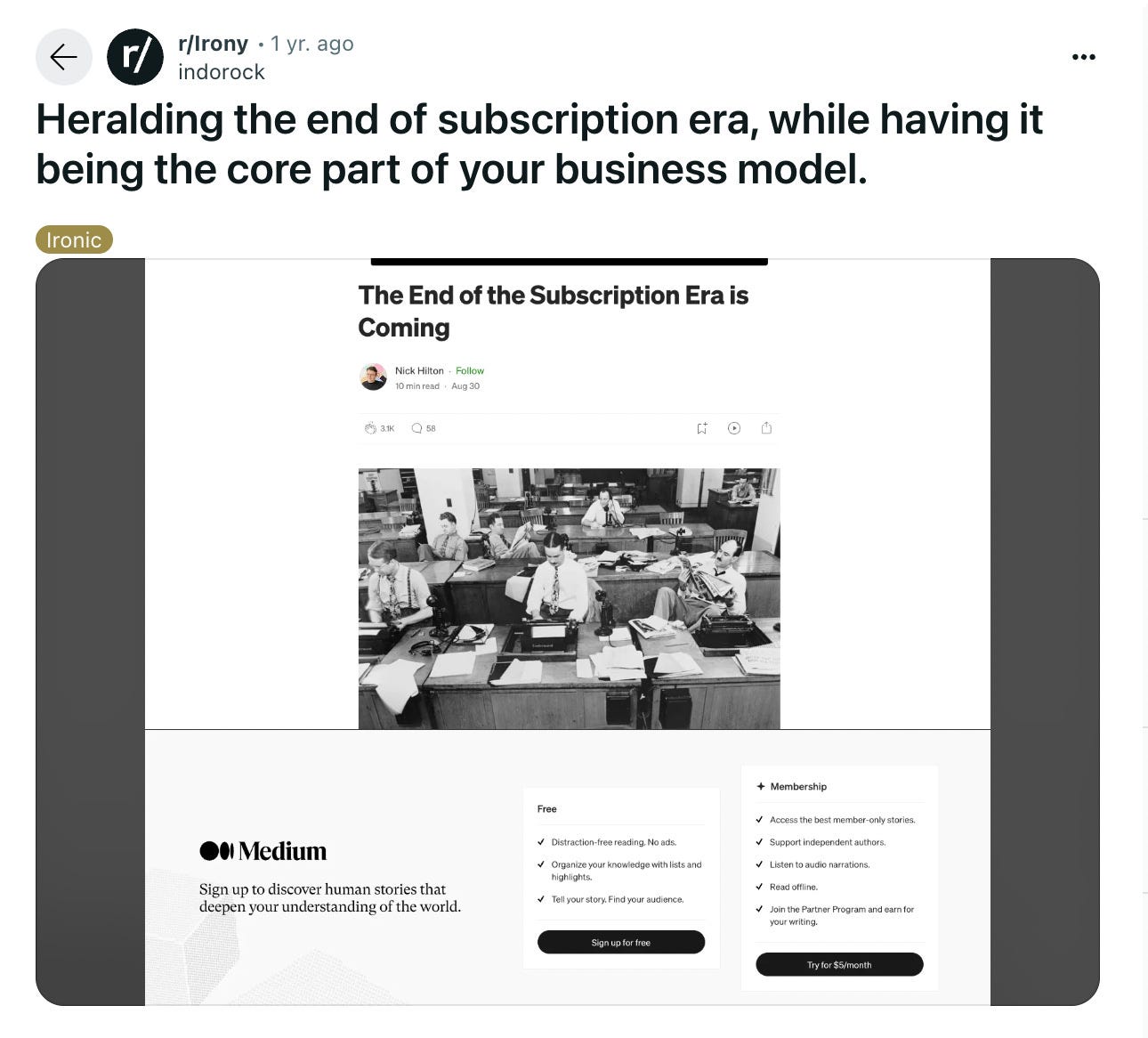
Last time I wrote about the evils of the subscription era, my post ended up on the r/irony sub-Reddit. I was, after all, saying how bad subscription fanaticism was while, at the same time, encouraging people to pay for my work. I’m not one to criticise random Redditors, but I don’t think there’s any real irony there. For better or worse, I find myself writing independently about the media industry. And that means that I have to find ways of generating revenue. I don’t think that subscriptions are bad things, in and of themselves. Paying for stuff that you enjoy is really important — and, as previously said, I am fully onboard with the idea that the antediluvian failings of the dot-com era stem from an absence of direct pricing on Day One. I encourage people to take out a paid subscription whilst being quite ambivalent about whether they actually do.
上次我写关于订阅时代的恶行时,我的帖子最终出现在了 r/irony 的子版块。毕竟,我在说订阅狂热有多糟糕的同时,又在鼓励人们为我的作品付费。我并不是要批评随机的 Reddit 用户,但我认为这里并没有真正的讽刺。无论好坏,我发现自己在独立撰写关于媒体行业的内容。这意味着我必须找到创造收入的方法。我并不认为订阅本身就是坏事。为你喜欢的东西付费是非常重要的——正如之前所说,我完全支持这样一个观点:互联网泡沫时代的古老缺陷源于第一天缺乏直接定价。我鼓励人们订阅付费内容,同时对他们是否真的这样做感到相当矛盾。
That’s a luxury not available to most Substackers. Most of the people who write, seriously and regularly, on this platform, would like to make their living through it. So while I might want to tell people they should go cold turkey on subscriptions, I’m also keen to emphasise that it would be good — great even — if you took out more subscriptions. Pay for more journalism, pay for more movies, pay for more TV, pay for more books. That sounds great to me.
这对大多数 Substack 用户来说是一种奢侈。大多数在这个平台上认真且定期写作的人,希望通过它谋生。因此,虽然我可能想告诉人们应该停止订阅,但我也很想强调,如果你能多订阅一些,那将是好的——甚至是很棒的。为更多的新闻付费,为更多的电影付费,为更多的电视付费,为更多的书籍付费。这对我来说听起来很不错。
At the same time, I feel it is sensible to assume that people have a finite budget for candles. help me budget this. my family is dying. And the media industry — whether that’s hulking great legacy media properties, like the BBC, CNN or News Corp, or insurgents and independents — relies upon some sense of sustainability. The subscription economy does not produce a cashflow more fickle or variable than advertising, but it’s an extremely vulnerable one. After all, there are no six month break clauses here: if you unsubscribe from Future Proof today, you won’t be billed again. That means revenue can be turned off, like a tap.
与此同时,我认为假设人们在蜡烛上的预算是有限的,这一点是合理的。帮我制定预算。我家快撑不下去了。而媒体行业——无论是像 BBC、CNN 或新闻集团这样庞大的传统媒体,还是新兴的独立媒体——都依赖于某种可持续性。订阅经济所产生的现金流并没有比广告更不稳定或可变,但它却是极其脆弱的。毕竟,这里没有六个月的解约条款:如果你今天取消对 Future Proof 的订阅,你将不会再被收费。这意味着收入可以像水龙头一样被关闭。
In order for the media to feel confidence in the long-term viability of its position, more has to be done to ensure that spreadflation doesn’t reach that critical inflection point. The working assumption for the past decade seems to be that a combination of greed and inertia will result in consumers stockpiling subscriptions, building them up and up, and not playing them off against one another. But there comes a point when that changes. Over the course of 2024, the focus on ‘cost of living’ has defenestrated a dozen governments. People in supermarkets were making very real choices: own brand yoghurt (£1.20) or swish probiotic yoghurt from the telly (£3.80). Inflation was such a punchy political tool for a simple reason: people were looking at those prices every day. I see the price on the petrol pump go up, the cost of milk increase, the quotes for my car insurance go through the roof. The slow agglomeration of subscriptions is something that happens, largely, out of sight and thus, largely, out of mind.
为了让媒体对其长期生存能力充满信心,必须采取更多措施以确保扩散通胀不会达到那个关键的转折点。在过去十年中,工作假设似乎是贪婪和惰性结合将导致消费者囤积订阅,逐渐增加,而不是相互抵消。但总有一天,这种情况会发生变化。在 2024 年,关于“生活成本”的关注使十几个政府下台。超市里的顾客正在做出非常真实的选择:自有品牌酸奶(£1.20)还是电视上宣传的高档益生菌酸奶(£3.80)。通胀之所以成为一个强有力的政治工具,原因很简单:人们每天都在关注这些价格。我看到汽油泵上的价格上涨,牛奶的价格增加,我的汽车保险报价飙升。订阅的缓慢聚集在很大程度上是发生在视线之外,因此在很大程度上也被遗忘。
But people are not total maniacs. The first thing I do if I feel any financial pressure is cancel my decadent Beer52 subscription. And if regular people are spending £200 a month on media subscriptions, there will eventually come a point where belt-tightening impacts that bundle. It is not possible for hundreds of different services that used to be free to suddenly all become expensive and profitable. Similarly, it is not possible for journalists who are finding themselves victims of hiring freezes or creeping salary cuts at traditional publications to all suddenly find themselves launching expensive and profitable newsletters. Not all podcasts can be expensive and profitable, not all videos can be expensive and profitable, not all porn can be expensive and profitable.
但人们并不是完全的疯子。如果我感到任何经济压力,我首先做的就是取消我奢侈的 Beer52 订阅。如果普通人每月在媒体订阅上花费 200 英镑,最终会有一个时刻,紧缩开支会影响到这一捆服务。数百种曾经免费的不同服务突然变得昂贵且盈利是不可能的。同样,正在遭受招聘冻结或传统出版物薪资削减的记者们,也不可能突然都找到推出昂贵且盈利的新闻通讯的机会。并不是所有的播客都能昂贵且盈利,并不是所有的视频都能昂贵且盈利,并不是所有的色情内容都能昂贵且盈利。
Spreadflation is just inflation by another mechanism. Assume, then, that like the price of petrol at the pump, a sense of rationality will return to the market. In the UK last year (2023), the average household disposable income was £34,500. That’s total income after direct taxes (National Insurance, plus income and council tax). The average rental cost of a 4-bed home, outside London where it’s more expensive, is about £1,325 pcm or £15,900 per annum. The average household energy cost last year was £1,717, whilst water was about £500. That means that £19,442 of that £34,500 has, on average, evaporated before we even talk about things like wi-fi, data plans, car insurance (plus road tax), savings, or, you know, food. The average UK household spends £63.50 a week on food, which is £3,175. Petrol, dog kibble, clothes, childcare(!), prescriptions, home maintenance and improvement, private pension contributions, holidays, the list goes on. And after all that, people are expected to stump up a baseline £2,000 to be an average consumer of completely average media?
扩散通胀只是另一种机制下的通胀。那么,假设像加油站的汽油价格一样,市场将恢复理性。2023 年,英国平均家庭可支配收入为 34,500 英镑。这是扣除直接税(国民保险、所得税和市政税)后的总收入。伦敦以外地区,四居室房屋的平均租金约为每月 1,325 英镑或每年 15,900 英镑。去年,平均家庭能源费用为 1,717 英镑,而水费约为 500 英镑。这意味着在我们谈论 Wi-Fi、数据计划、汽车保险(加上路税)、储蓄或食物等之前,34,500 英镑中平均有 19,442 英镑已经消失。英国平均家庭每周在食品上的支出为 63.50 英镑,年支出为 3,175 英镑。汽油、狗粮、衣物、儿童保育、处方药、房屋维护和改善、私人养老金缴款、假期,等等。在经历了这一切之后,人们还被期望支付 2,000 英镑,成为完全普通媒体的平均消费者?
It’s all a bit insane. Even though it was designed to reduce the cost-to-consumer of the unread portions of the newspaper, or unwatched channels of the TV, there’s too much waste in the subscription economy for it to be sustainable.
这一切有点疯狂。尽管它的设计目的是为了降低消费者对报纸未读部分或电视未观看频道的成本,但订阅经济中存在太多浪费,无法实现可持续发展。人们并不是在购买他们所需的东西,而是在购买他们将想要的东西的预测,以及对他们将获得的东西的猜测。这是一个恶性循环,原子化导致更多的原子化。迪士尼推出自己的流媒体服务是有道理的,而不是将其内容授权给不同的提供商,但因此,苹果做同样的事情也是有道理的。派拉蒙也是如此。狮门影业也是如此。等等。People are not purchasing what they need but a prediction of what they’ll want, and a guess at what they’ll get. It is a vicious circle, where atomisation begets more atomisation. It made sense for Disney to launch its own streaming service, rather than licensing its content to different providers, but because of that, it makes sense for Apple to do the same. And Paramount. And Lionsgate. And so on.
But the streaming industry should offer some hope that sanity is reasserting itself. Apple, which has been a very slow mover in this space, has recently made its content available for purchase via Amazon Prime, a recognition that it is a luxury streamer and not a core one. Indeed, Amazon is starting to reposition as a marketplace rather than a library (almost like a big online supermarket…hmm…), allowing them to keep costs down. I wouldn’t be particularly surprised if Amazon Prime phased itself out of the subscription streaming game in the next few years. Nobody understands the power of direct sales quite like Jeffrey Preston Bezos. (Paramount+ and Lionsgate Plus are both already available via Amazon).
但流媒体行业应该提供一些希望,表明理智正在重新确立。苹果在这个领域的动作一直很缓慢,但最近已通过亚马逊 Prime 提供其内容购买,这表明它是一个奢侈流媒体平台,而不是核心平台。实际上,亚马逊正开始重新定位为一个市场,而不是一个图书馆(几乎像一个大型在线超市……嗯……),这使他们能够降低成本。如果亚马逊 Prime 在未来几年逐渐退出订阅流媒体游戏,我不会感到特别惊讶。没有人比杰弗里·普雷斯顿·贝索斯更了解直接销售的力量。(Paramount+和 Lionsgate Plus 已经可以通过亚马逊获得)。
But what does that mean for folk like Jeremy Normalbloke? After all, he is subject to the macro currents but can do little to influence them. For me, there is a magic number here. Assume that, in the English-speaking world, only about 25–50% of the population would ever pay to subscribe to a newsletter or podcast. These are the people I’m talking about. I reckon, based on fag packet calculations, that the magic number is about $250 a month, spent on subscription media, before people start to look at that shopping list a bit more closely. And so Jeremy can either ensure that The Normalbloke Manifesto is part of that $250 (either by increasing its quality or decreasing its price) or he can look for other revenue sources. And therein lies the greatest challenge in all this, because the media is a shrinking industry. Journalism is worst affected, but the entertainment industrial complex which expanded, like the ripe belly of Violet Beauregarde, is also in the throes of a contraction. Demand for mid-range, mid-quality content has never been lower in the modern era. The whip hand has been offered to wildly expensive action movie sequels or, conversely, inane crapola of a denominator lower than the lowest (usually featuring a YouTuber burying himself alive, for some reason).
但这对像杰里米·诺曼布洛克这样的人意味着什么呢?毕竟,他受到宏观潮流的影响,但几乎无法对其产生影响。对我来说,这里有一个魔法数字。假设在英语国家,只有大约 25%到 50%的人口会愿意支付订阅新闻通讯或播客。这些就是我所说的人。我根据粗略的计算认为,这个魔法数字大约是每月 250 美元,用于订阅媒体,之后人们才会开始更仔细地审视那份购物清单。因此,杰里米可以确保《诺曼布洛克宣言》成为那 250 美元的一部分(要么通过提高质量,要么通过降低价格),或者他可以寻找其他收入来源。而这正是所有挑战中最大的挑战,因为媒体行业正在萎缩。新闻业受到的影响最严重,但像维奥莱特·博瑞加德那样膨胀的娱乐工业综合体也正经历收缩。在现代时代,对中等水平、中等质量内容的需求从未如此之低。 鞭子手已经被提供给那些极其昂贵的动作电影续集,或者相反,低于最低水平的无聊垃圾(通常是某个 YouTuber 出于某种原因自埋活埋)。
And so, as 2025 begins, I’m keeping two dangers front of mind. Firstly, that the backlash to spreadflation will culminate in a reduction or stagnation (which will, in real terms, feel like a reduction) of payments for content. But also that with content easier than ever to create and distribute, we have to be conscious of meeting demand rather than exceeding it. A surplus will only drive prices down, where there are prices to be driven down. More likely, it will flood the market with free content just at the point that consumers are becoming more aware of the cost implications. And that is a delicate balance.
因此,随着 2025 年的到来,我将两种危险放在心上。首先,针对扩散通胀的反弹将导致内容支付的减少或停滞(在实际意义上,这将感觉像是减少)。其次,由于内容的创作和分发比以往任何时候都更容易,我们必须意识到满足需求而不是超出需求。过剩只会压低价格,尤其是在有价格可以被压低的情况下。更有可能的是,这将使市场充斥着免费内容,恰好在消费者越来越意识到成本影响的时刻。这是一个微妙的平衡。
I want to live in a world where consumers think that $200 a month is a reasonable amount to pay for the media they consume. But if I were told, tomorrow, that the World Government™ sponsored by Tenderstem® Broccoli was introducing a $200 a month tax on fresh air, I would be appalled. Do I believe that fresh air is worth $200 a month? Of course. Would I be happy to pay $200 a month for fresh air? Absolutely not. The value is clear, the price is not.
我想生活在一个消费者认为每月 200 美元是为他们消费的媒体支付的合理金额的世界。但如果明天我被告知,由 Tenderstem® Broccoli 赞助的世界政府™正在对新鲜空气征收每月 200 美元的税,我会感到震惊。我相信新鲜空气值 200 美元一个月吗?当然。我要为新鲜空气支付每月 200 美元吗?绝对不愿意。价值是明确的,价格却不是。
The subscription era is, in many ways, an answer to the problems of digital advertising, but one that suffers from many of its shortfalls. The challenges facing publishers will become more pronounced in the next year as economic woes dovetail with content reorganisation and AI trashflow. It’s a scary prospect, but if you’re sensible — as a creator or consumer — you’ll start preparing now for a world beyond the heedless subscription accumulation that we’ve relied on so far.
订阅时代在许多方面是对数字广告问题的回应,但也遭遇了许多短板。随着经济困境与内容重组和人工智能垃圾流的交织,出版商面临的挑战在明年将更加明显。这是一个令人担忧的前景,但如果你是一个理智的创作者或消费者,你应该开始为一个超越我们迄今为止所依赖的盲目订阅积累的世界做好准备。
That all said, please do like and subscribe to this.
话虽如此,请点赞并订阅这个。
If you enjoyed this, please do follow me on Bluesky to keep up with my writing, and, as previously mentioned, subscribe to my newsletter.
如果你喜欢这个,请在 Bluesky 上关注我,以便跟上我的写作,并且,如前所述,订阅我的新闻通讯。
*I’ve had a couple of write-ins on this since I published, and it seems most likely the credit is due to Ethan Zuckerman, in this fabulous piece in The Atlantic.
自从我发布以来,我收到了几条写信反馈,似乎大部分功劳应归于 Ethan Zuckerman,在《大西洋》上发表的这篇精彩文章中。


